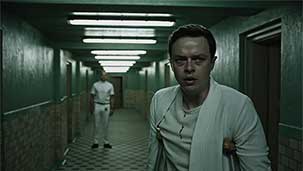I know I was supposed to be scared witless by Gore Verbinski’s A Cure for Wellness, and normally I would have been. As someone who is deathly afraid of pigeons, because what the actual fuck are they staring at me like that for, I’m an easy mark for horror movies. But this hot mess of cheap scares and tortured allegory annoyed me more than it scared me. Aside from the fact that the film ends about eight times before it actually ends, the underlying themes and narrative subtext are exasperatingly jumbled.
Your script gleefully plays upon our most common phobias - drowning, darkness, the dentist, geriatric nudity - to tell us a cautionary tale about the dangers of working too hard and being too obsessed with wellness. Or something. After a bunch of eels started slithering around in toilets I had no idea what the hell was going on anymore.
But then another narrative starts to emerge, shaped upon themes of purity and tropes of imprisonment, and things got a little uncomfortable for me. The underlying tale of a set of diseased, deadly beliefs, lurking until regaining their former strength and power, is the real horror here, but it falls flat when you consider the real-life resurgence of the same.
I think your basic underlying premise was this: The film is about Nazism. The evil, dastardly, purity-obsessed Nazis we thought were long gone have been hiding and recouping their strength this whole time, rounding up innocent people and conducting terrible experiments on them before exterminating them and just being generally Aryan and horrid. Normally, there would be much satisfaction and narrative catharsis when the evil Nazis/Nazi stand-ins get their comeuppance, but I just wasn’t feeling it. Were you pointing frantically from the Nazi-esques in your script to the real-life alt-right horror show currently unfolding in our own back yards while screaming, “It’s the same damn thing!”? Because that is more frightening than your water tank scene, your eel scene, and your aggressive dentist scene.
In the decades since WWII, while we’ve solemnly intoned, “Never again, never again,” we have enjoyed a variety of cultural product where Nazis or Nazi-ish bad guys are dealt with violently and mercilessly. We cheer on the avenging heroes and fervently wish they had been around ‘back then’. Well, Nazi-ish appears to be back in vogue, and today, a film like Inglourious Basterds would probably end with a lecture about the importance of dialogue and respect for the Nazis’ freedom of speech. And perhaps you see the horror in that too. When the protagonist Lockhart confronts Nazi-ish bad guy Dr. Volmer over his Nazi-reminiscent misdeeds against his unsuspecting clientele, the latter purrs, “It was easier this time, with such willing pawns.”
Your Nazi allegory is the truly terrifying heart of the film, and it could have been pretty compelling if you had just focused the narrative around it from the get-go. I guess I just didn’t see the point of all that other crap about the evils of greed, or corporatism, or whatever you seemed to be taking aim at initially. Your story tried to be about too many things at once, or was initially about one thing, then changed its mind and decided to be about something else.
If the horror film is a vehicle through which our deepest underlying fears and anxieties over the state of the world play out, the next four to eight years will likely produce a steady stream of fright-fests featuring vaguely (or blatantly) Germanic villains and monsters, with brave protagonists sending them back to Hell, all like, “Not today, Franz!” But the horror on screen is no longer quite as hair-raising as the real world spectres that return for unwanted and unwelcome sequels (that was not a suggestion to write a sequel to this film. Please don’t).
Best,

Nat







